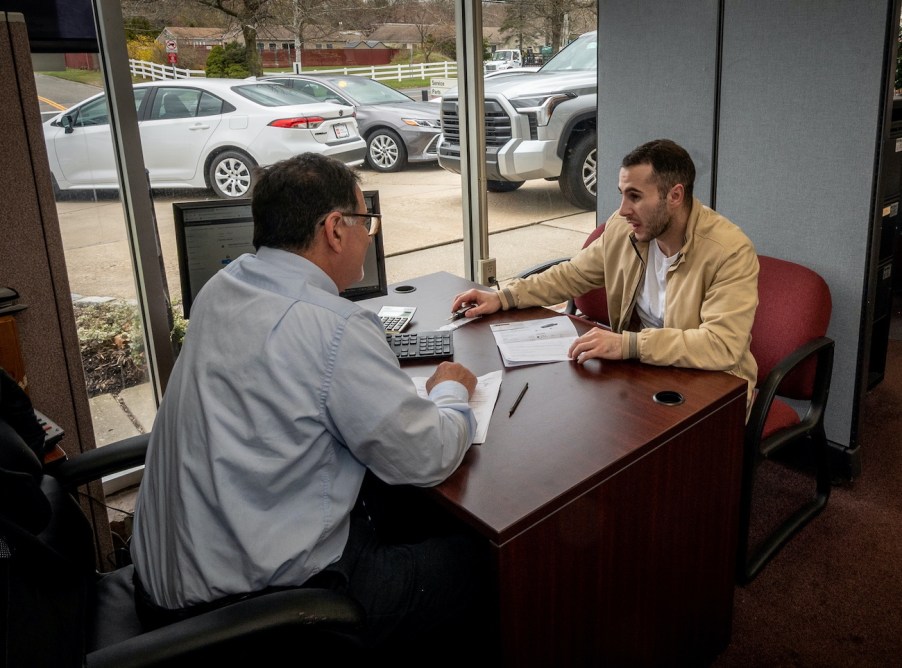
3 Car Buying Myths You Don’t Need to Worry About
Buying a new car from a dealer can be a challenging experience for many people. As a result, most go in with tips, tricks, or secrets they’ve heard from family or friends that will supposedly help with the process. However, many of the most common recommendations when buying a car aren’t true. Some car-buying myths have long been busted, and modern buyers don’t need to think about them. Here are a few car-buying myths you don’t need to worry about.
What is a car-buying myth?

First, according to Edmunds, car-buying myths are primarily from a long time ago. They’re ideas used to try to “get” the salesperson or somehow turn the tables in your favor. In the modern era, almost nothing like these ideas will actually work. Dealers have access to exactly how much every vehicle is worth. They know your trade-in’s value down to the VIN and how much they can afford to sell their own inventory for without losing money. Nothing a customer can do or say will enable a dealer to drop the price lower than the point of no return.
Instead of trying to outsmart a car salesperson trying to screw you, leave that dealer. Some salespeople and dealers will work with you and get you a decent deal. However, they’re not going to take a loss to help a random buyer. If you’re working with a salesperson who seems to be trying to get the better of you, just walk away and forget about that car.
Does buying a car on a rainy day help?

One of the most common myths is buying a car on a rainy day will help a buyer get a better deal. It suggests the dealer is desperate to get rid of cars because it’s raining. As a former dealer employee, I can confirm this is not the case. Many people have heard this same rumor, and therefore, the opposite is true. Not only will rain make your car-buying experience less pleasant from being wet and not providing a great deal, but the dealership is also often more crowded.
Edmunds mentioned a variation of the same idea is going to a dealer right before it closes. Some buyers think going close to closing time will get them a deal because everyone wants to go home. Again, as a former employee, I can confirm that everyone wants to go home. However, not a single salesperson or sales manager will drop the price to please you. They’d instead tell you the deal can’t get done at that price and pack up for the night, hoping you’ll call back tomorrow.
Should you hide your trade-in?

Some people think hiding their trade-in while negotiations are ongoing is a good idea. Springing the vehicle on the salesperson when it’s too late is not going to sit right with them. In my experience, it’s much worse to do this because the sales staff think you’re trying to screw them. In addition, most salespeople have heard of this strategy and are perfectly prepared. Don’t think for a second that the staff member you’re working with hasn’t already scouted out the vehicle in which you first entered the parking lot.
The best course of action for trade-ins is to use the internet to find how much your trade is worth ahead of time. Print out information or have it readily available on your phone to prove what it’s worth. However, ensure you’re paying close attention to issues with your trade-in. Dealers will not miss a single scratch, scuff, dent, or irregular engine noise when determining your trade’s value. Don’t get your hopes up about the Kelley Blue Book evaluation. Most models aren’t in excellent condition, no matter how badly you’d like them to be.
Does bringing the exact amount of cash work?
Finally, the last myth we’re busting is for bringing cash or a cashier’s check. Many customers think bringing in the exact amount they want to pay for a car is a good idea. Whether it’s cash or a cashier’s check, presenting it to the dealer employee will not work. Depending on the amount, all you’re doing is revealing that you have readily available car-buying money. As a result, the dealer will not budge on price, and you’ll be headed to the bank to get more money.
Don’t get me wrong, paying cash is still enticing for dealerships today. However, as we said earlier, the employees know their limits. If a car has to sell for at least $20,000 to make any profit from the amount the dealer bought it for, the price isn’t dropping under $20,000. It doesn’t matter if you have cash, a cashier’s check, or any other form of payment. Additionally, there will always be taxes, fees, and additional costs you probably didn’t calculate into your cashier’s check before entering the dealer.
Don’t worry about these car-buying myths
In conclusion, these are just some car-buying myths you don’t need to worry about. Trying to out-screw the sales staff seems like a good idea for many people. However, it isn’t what it used to be. Usually, everyone involved knows the value of the vehicle that’s for sale. Almost nothing you can do is going to change that evaluation. Buying on a rainy day, hiding your trade-in, and bringing cash are tricks that will not work. Don’t count on these gimmicks to get a good deal for your next vehicle purchase.



